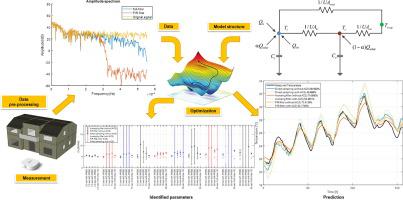Energy and Buildings ( IF 6.6 ) Pub Date : 2021-02-01 , DOI: 10.1016/j.enbuild.2021.110775 Xingji Yu , Laurent Georges , Lars Imsland

|
Grey-box models are data-driven models where the structure is defined by the physics while the parameters are calibrated using data. Low-order grey-box models of the building envelope are typically used for two main applications. Firstly, they are used as a control model in Model Predictive Control (MPC) where the thermal mass of the building is activated as storage (for instance in demand response). Secondly, they are used to characterize the thermal properties of the building envelope using on-site measurements. The influence of the data pre-treatment on the performance of grey-box models is hardly discussed in the literature. However, in real applications, information about data pre-processing by sensors or data acquisition systems is expected to be limited. Therefore, the influence of the sampling time, low-pass filters and anti-causal shift (also called data labeling) are analyzed for grey-box models in deterministic and stochastic innovation form. The influence on the optimizer performance is also investigated. The datasets are generated from virtual experiments using multi-zone building performance simulations of a residential building (in lightweight wooden construction) heated using different types of excitation signals. Results show that the parameters of deterministic grey-box models are significantly influenced by the training data while the data pre-treatment has a limited impact on the model and optimizer performance. Depending on the training data, the value taken by some parameters is not physically plausible. On the contrary, stochastic models are significantly influenced by the data pre-treatment, especially the sampling time, and less by the training data. The parameters can become non-physical for large sampling times. However, the anti-causal shift proves to be efficient to keep the parameters almost constant with increasing sampling times. Even though the parameter values of the deterministic model are less physically plausible, the simulation performance of deterministic models is higher than using the equivalent stochastic models. These results suggest that deterministic models seem better suited for MPC while stochastic models are better suited for the characterization of thermal properties (if suitable data pre-treatment is applied).
中文翻译:

随机和确定性住宅低阶灰箱模型的数据预处理和优化技术
Grey-box模型是数据驱动的模型,其中结构是由物理定义的,而参数是使用数据进行校准的。建筑围护结构的低阶灰箱模型通常用于两种主要应用。首先,它们在模型预测控制(MPC)中用作控制模型,在该模型中,建筑物的热质量被激活为存储(例如在需求响应中)。其次,它们用于通过现场测量来表征建筑物围护结构的热性能。文献中很少讨论数据预处理对灰盒模型性能的影响。但是,在实际应用中,有关传感器或数据采集系统进行数据预处理的信息预计会受到限制。因此,采样时间,低通滤波器和反因果转移(也称为数据标记)以确定性和随机创新形式分析灰盒模型。还研究了对优化器性能的影响。数据集是通过虚拟实验生成的,该虚拟实验使用的是使用不同类型的激励信号加热的住宅建筑(轻型木质建筑)的多区域建筑性能模拟。结果表明,确定性灰箱模型的参数受到训练数据的显着影响,而数据预处理对模型和优化器性能的影响有限。根据训练数据,某些参数所取的值在物理上不合理。相反,随机模型受数据预处理(尤其是采样时间)的影响很大,而受训练数据的影响较小。对于较大的采样时间,参数可能变得不物理。但是,那事实证明,反因果偏移可以有效地随着采样时间的增加而使参数保持几乎恒定。即使确定性模型的参数值在物理上不太合理,但确定性模型的仿真性能比使用等效的随机模型要高。这些结果表明,确定性模型似乎更适合于MPC,而随机模型则更适合于热特性的表征(如果应用了适当的数据预处理)。











































 京公网安备 11010802027423号
京公网安备 11010802027423号